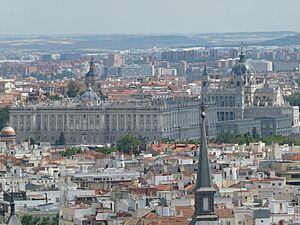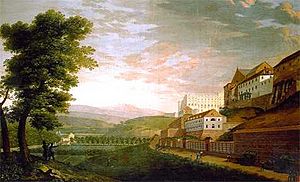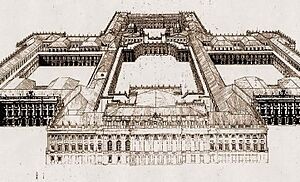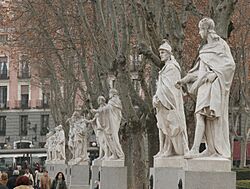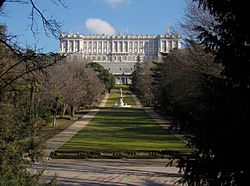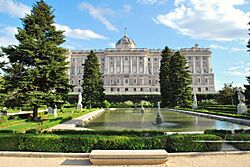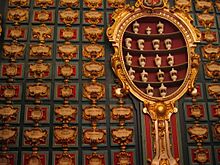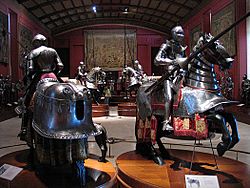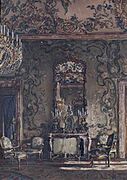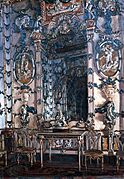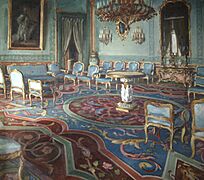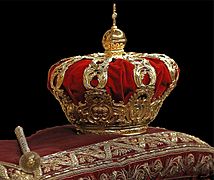Royal Palace of Madrid facts for kids
Quick facts for kids Royal Palace of Madrid |
|
|---|---|
|
Palacio Real de Madrid (Spanish)
|
|
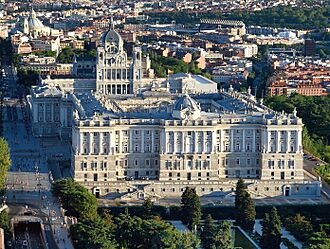
Aerial view
|
|
| General information | |
| Architectural style | Baroque, Classicism |
| Town or city | Madrid |
| Country | Spain |
| Coordinates | 40°25′05″N 03°42′51″W / 40.41806°N 3.71417°W |
| Construction started | 7 April 1735 |
| Client | King Philip V of Spain |
| Technical details | |
| Floor area | 135,000 m2 (1,450,000 sq ft) |
| Design and construction | |
| Architect | Filippo Juvarra (first of many) |
| Official name: Palacio Real de Madrid | |
| Type: | Non-movable |
| Criteria: | Monument |
| Designated: | 1931 |
| Reference #: | RI-51-0001061 |
The Royal Palace of Madrid (Spanish: Palacio Real de Madrid) is the official home of the Spanish royal family in Madrid, Spain. Even though it's the official residence, the royal family now uses it mainly for important state events and ceremonies. They live in another palace called the Palace of Zarzuela.
This huge palace has a floor area of 135,000 square meters and an amazing 3,418 rooms. This makes it the largest royal palace in all of Europe. The Spanish government owns the palace. It is managed by a public agency called Patrimonio Nacional, which means National Heritage.
The palace is located in the western part of downtown Madrid, near the Manzanares River. You can easily get there by using the Ópera metro station.
The Royal Palace stands on the spot where an old Muslim fortress was built in the 800s. Later, a grand castle called the Royal Alcázar of Madrid stood here. It kept the royal treasures safe and was home to kings for many years. This old castle was greatly expanded in the 1500s. Sadly, it burned down completely on Christmas Eve in 1734.
After the fire, a brand new palace was built on the same spot. Construction started in 1738 and finished in 1755. Many architects worked on it, including Filippo Juvarra, Giovanni Battista Sacchetti, Ventura Rodríguez, Francesco Sabatini, and Martín Sarmiento. During a time when Spain was a republic, the building was known as "Palacio Nacional."
The inside of the palace is famous for its incredible art and the beautiful materials used to build and decorate its rooms. You can see paintings by famous artists like Caravaggio, Francisco de Goya, and Diego Velázquez. There are also amazing ceiling paintings (frescoes) by Giovanni Battista Tiepolo and others. Many royal paintings that once hung here are now in other museums, like the Prado Museum in Madrid.
Other important collections in the palace include the Royal Armoury of Madrid, which has old weapons and armor. There are also collections of porcelain, watches, furniture, silverware, and the only complete set of Stradivarius string instruments in the world.
Contents
History of the Royal Palace
The story of the Royal Palace begins with a fortress built by Emir Muhammad I of Córdoba between 860 and 880. This fortress was important for defense. Later, Henry III of Castile added towers to it. His son, John II, used it as a royal home. The castle was damaged during a war in 1476.
The only old drawing of the castle from the Middle Ages is from 1534.
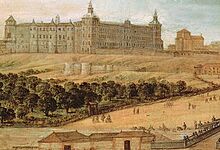
In 1537, Emperor Charles V expanded and fixed up the castle. When Philip II made Madrid the capital in 1561, he continued to add new parts. Later kings, Philip III and Philip IV, added a long southern side to the building between 1610 and 1636.
When Philip V became king in 1700, he found the old castle quite plain compared to the grand Palace of Versailles where he grew up. He started to redesign the royal rooms.
The Grand Fire and New Palace
On Christmas Eve in 1734, the old castle was destroyed by a fire. The fire started in the rooms of a French painter. People were slow to react because the fire alarms were mistaken for church bells. Also, the doors were kept locked to prevent stealing, which made it hard to save things. Many artworks were lost, but some, like the famous painting Las Meninas, were saved by throwing them out of windows. Luckily, many valuable items had been moved to another palace just before the fire. The fire lasted four days and completely destroyed the old castle. Its remaining walls were taken down in 1738.
Italian architect Filippo Juvarra was chosen to design the new palace. He planned a very grand building. Juvarra wanted to build the palace in a different spot, but that idea was dropped. His student, Giovanni Battista Sacchetti, continued the work. Sacchetti designed the palace with a large square courtyard and added wings to improve the views.
In 1760, Charles III asked another architect, Francesco Sabatini, to make the building even bigger. Sabatini planned to add more parts around the main square, but only a small part was finished. He also planned a large wing on the north side, but this work stopped early. The foundations for this wing were later covered, and royal stables were built there. These stables were removed in the 1900s and replaced by the Sabatini Gardens. Charles III moved into the new palace in 1764.
In the 1800s, Ferdinand VII started a big renovation to make the palace more modern, like French palaces. Later, his grandson Alfonso XII wanted to make it a Victorian-style home. He planned to change rooms, replace marble floors with wood, and add new furniture.
In the 1900s, after the Spanish Civil War, the palace needed repairs. Decorations were fixed or put back, and damaged walls were replaced to look just like the originals.
Today, the palace is open to the public. You can visit many rooms, though the specific route changes every few months. There is usually an entry fee, but sometimes it is free.
Outside the Palace
The main front of the palace faces the Plaza de la Armería. It has a strong stone base with two floors. Above this, tall Ionic columns and pilasters frame the windows of the three main floors. The very top of the building has a large balustrade (a row of small columns). This was once decorated with statues of saints and kings, but these were moved to other places by Charles III to make the building look more classical.
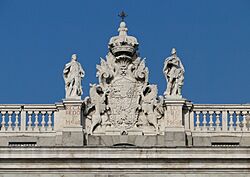
In 1973, the front of the palace was restored. Some of Sacchetti's sculptures were put back. These include statues of the Aztec ruler Moctezuma II and the Inca emperor Atahualpa. Other statues of Roman emperors were placed in the Prince's courtyard. Near the clock, there are statues of Philip V, Ferdinand VI, Barbara of Braganza, and Maria Luisa of Savoy. Above the clock is the royal coat of arms with angels. The bells above date from 1637 and 1761.
Plaza de la Armería
This square was designed in 1892. However, its history goes back to 1553, when Philip II ordered a building for the royal stables here.
The Almudena Cathedral stands across the square from the palace. Its outside style matches the palace, but its inside is neo-gothic. Construction of the church began in 1878 and finished in 1992.
Plaza de Oriente
The Plaza de Oriente is a rectangular park that connects the east side of the Royal Palace to the Teatro Real (Royal Theater). The eastern side of the plaza is curved and has cafes nearby. This plaza was part of the original plan for the palace, but construction didn't start until 1808. King Joseph Bonaparte ordered the demolition of about 60 old buildings, including a church and monastery, to make space. Joseph was removed from power before it was finished. Queen Isabella II completed it in 1844.
Pathways divide the Plaza into three main garden areas. The Central Gardens are arranged in a grid around a statue of Philip IV. They have seven flowerbeds with hedges, cypress trees, and magnolias. The north and south edges of these gardens have a row of statues, often called the Gothic kings. These sculptures represent Visigoth rulers and early Christian kings of Spain. They were made between 1750 and 1753 for the palace, but engineers thought they were too heavy for the palace roof, so they were placed on the ground.
Isabella II arranged the grounds so that the statue of Philip IV was in the center, facing the Prince's Gate.
Campo del Moro Gardens
These gardens are named after a Muslim leader, Ali ben Yusuf, who supposedly camped here with his troops in 1109. King Philip IV made the first improvements, adding fountains and plants. However, the gardens were mostly neglected until Isabella II started serious work. The park was designed in the Romanticist style, which was popular at the time.
Two fountains, the Triton fountain and the Fountain of the Shells, were placed in the center of the pathways by Isabella II. Later, the park was redesigned again. Between the Triton fountain and the palace is a large grotto (cave-like structure) built by Juan de Villanueva.
Sabatini Gardens
The Sabatini Gardens are next to the north side of the Royal Palace. They follow a symmetrical French design. Work on them began in 1933. They are named after Francesco Sabatini, who designed the royal stables that used to be on this site. These gardens have a large rectangular pond surrounded by four fountains and statues of Spanish kings. These statues were originally meant to be on top of the Royal Palace.
The gardens were built to give the public access to an area that was once controlled by the royal family. They were opened to the public in 1978 by King Juan Carlos I.
Inside the Palace
Ground Floor Highlights
Grand Staircase
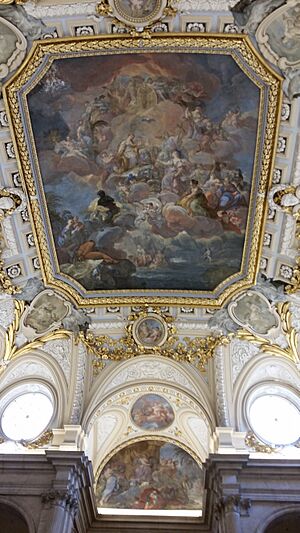
This grand staircase was built in 1789. It is made from a single piece of San Agustin marble. Two lion statues guard the landing. The ceiling painting (fresco) by Corrado Giaquinto shows Religion Protected by Spain. On the ground floor, there is a statue of Charles III in a Roman toga.
Royal Library
The Royal Library was moved to the lower floor. The bookshelves are from different time periods, showing how styles changed.
Some special items in the collection include a Book of hours that belonged to Isabella I of Castile, and an old Bible. There are also important maps that show the size of the Spanish Empire. The library also displays beautiful medals from the Royal Collection.
The book covers show how bookbinding styles changed over time, from fancy Rococo to more classic Neoclassical designs.
The Archives of the Royal Palace hold about twenty thousand items. These include old letters from kings and important documents.
Royal Pharmacy
Since the time of Philip II, the Royal Pharmacy has been part of the royal household. It was responsible for providing medicines, and it still does today.
The collection includes beautiful jars made in different places in Spain during the 1700s and 1800s.
Royal Armory
The Royal Armoury is considered one of the best in the world, along with the one in Vienna. It has pieces dating back to the 1200s. This collection includes weapons and armor once worn by kings and their best soldiers. The building for the armoury opened in 1897.
A highlight of the collection is the special armor made for Charles V and Philip II. One famous piece is the armor Emperor Charles V wore in the Battle of Mühlberg. Sadly, some parts of the collection were lost during wars.
Still, the armoury has some of the most important pieces of this art in Europe. This includes a shield and helmet made by Francesco and Filippo Negroli, who were very famous armor designers.
First Floor Highlights
King Charles III's Apartments
The Halberdier's Room, or Guard Room, has a ceiling fresco by Tiepolo showing Venus and Vulcan.
The Hall of Columns has a ceiling fresco by Giaquinto, which shows the sun waking up nature. This is a way of showing the king as Apollo. There is also a bronze statue of Charles V Vanquishing Fury.
The Throne Room dates from 1772. It features Tiepolo's ceiling fresco, The Apotheosis of the Spanish Monarchy. Bronze sculptures of virtues and planets are also in this room.
Charles III's Anteroom has a ceiling fresco from 1774. The Antechamber of Charles III also has a ceiling fresco by Anton Raphael Mengs. This room displays four royal family portraits by Goya.
The Queen's Apartments and Banqueting Hall
These three rooms were once the queen's apartments. They were turned into a large banquet hall by Alfonso XII in 1879. The three original ceiling frescoes remained. One shows Dawn in Her Chariot, another shows Christopher Columbus Offering the New World to the Catholic Monarchs, and the third shows Boabdil Giving the Keys to Granada to the Catholic Monarchs.
Apartments of Infante Luis
These rooms were once used by Infante Luis, Count of Chinchón. The Stradivarius Room now holds a viola, two cellos, and two violins made by Stradivari. The ceiling fresco shows Gentleness accompanied by the Four Cardinal Virtues.
The Musical Instruments Room has a ceiling fresco by Francisco Bayeu.
Royal Chapel
Designed in 1748, the chapel features ceiling frescoes by Giaquinto, including The Trinity. Above the High Altar is St. Michael.
The Crown Room
This room was once the apartment of Alfonso XIII's mother, Maria Christina of Austria. It now holds Charles III's throne, scepter, and crown. Tapestries showing the Four Seasons decorate the walls. Important speeches, like the abdication speech of Juan Carlos I and the proclamation speech of Felipe VI, are also displayed here.
Gallery
Recent Events
The wedding banquet for Prince Felipe and Letizia Ortiz took place on May 22, 2004, in the central courtyard of the palace.
See also
 In Spanish: Palacio Real de Madrid para niños
In Spanish: Palacio Real de Madrid para niños
- Project of Filippo Juvarra for the Royal Palace of Madrid
- Palacio del Buen Retiro (another royal palace in Madrid, now mostly demolished)
- Royal Palace of El Pardo
- Royal Palace of Aranjuez
- Royal Palace of La Granja de San Ildefonso
- Royal Palace of La Almudaina
- Royal Palace of Valladolid


